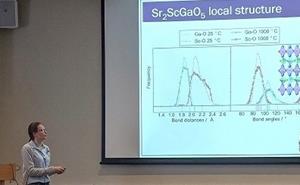Their study into the structure and dynamics of Sr2Sc0.6Zn0.4GaO4.8 used X-ray and neutron diffraction, neutron total scattering and pair distribution function (PDF) analysis, impedance spectroscopy, and neutron spectroscopy. They found that the material showed a significant increase in oxide-ion conductivity compared to Sr2ScGaO5, caused by the change in structure supporting a high level of oxygen deficiency and disorder across a wide temperature range.
Materials with the general formula A2B2O5 can adopt an oxygen-deficient perovskite-type structure. In this structural form, the oxide vacancies are often ordered in a way that limits the conductivity through the material. For example, the material Sr2ScGaO5, previously characterised by the same group using neutrons at ISIS and ILL, is only a modest oxide ion conductor.
By introducing small quantities of zinc (Zn) into the structure, this conductivity can be improved significantly. Adding Zn introduces oxygen defects into the material, but also changes its average structure by introducing extra tetrahedrally coordinated metal sites compared to the 1:1 ratio of tetrahedra and octahedra in the parent material. In this study, published recently in Chemistry of Materials, the researchers combined these approaches to form Sr2Sc1–xZnxGaO5–0.5x, where x = 0.1–0.6, and study the effect of these changes on the structure and oxide dynamics.
Alongside a range of laboratory techniques, the research group used neutron powder diffraction at ANSTO, neutron total scattering on Polaris at ISIS and inelastic neutron scattering and quasi-elastic neutron scattering at ILL to study the material over a range of x values, including a detailed study at the composition SrSc0.3Zn0.2Ga0.5O2.4 (SSZ40GO).
Their work found that SSZ40GO formed a highly disordered perovskite structure, with a remarkably low oxygen content. It also showed an increase in conductivity over its parent material Sr2ScGaO5 of two orders of magnitude at high temperature.
They also found that the local structure of SSZ40GO is markedly different from its average perovskite structure. Using the neutron total scattering data, they saw that the local environments around the metal ions include half of the tetrahedra with the unusual structural feature of a terminal oxygen site. They believe that this terminal oxygen could contribute to the higher oxide ion conductivity.
The PhD student involved, Chloe Fuller, discusses the work in more detail in the live slide presentation linked through the image below:

Further information
The full paper can be found at DOI: 10.1021/acs.chemmater.0c01378
